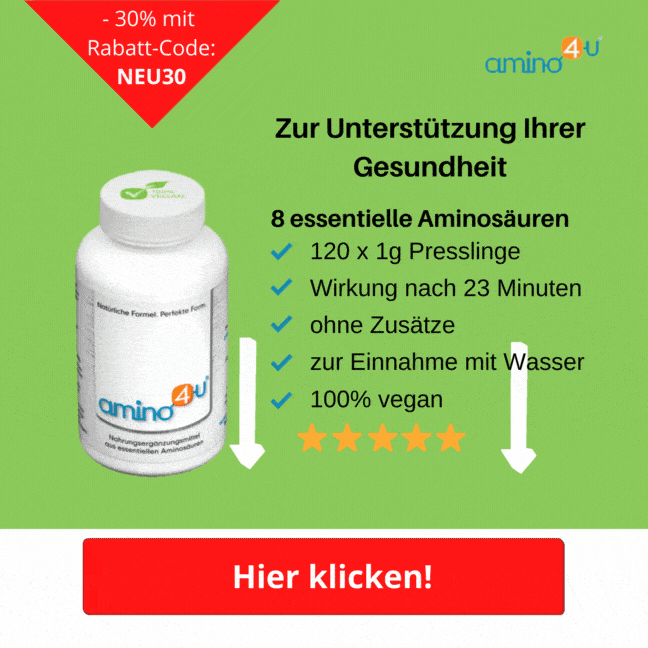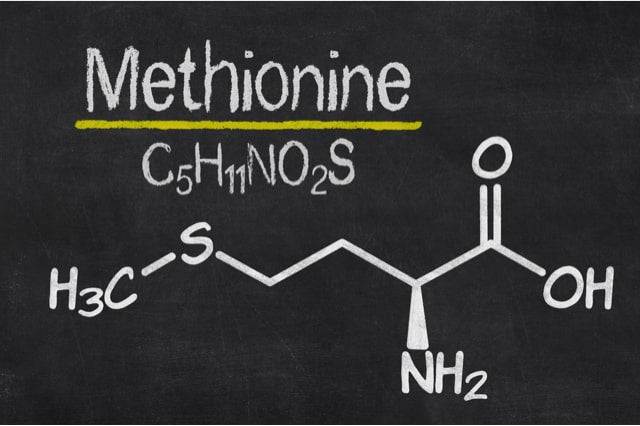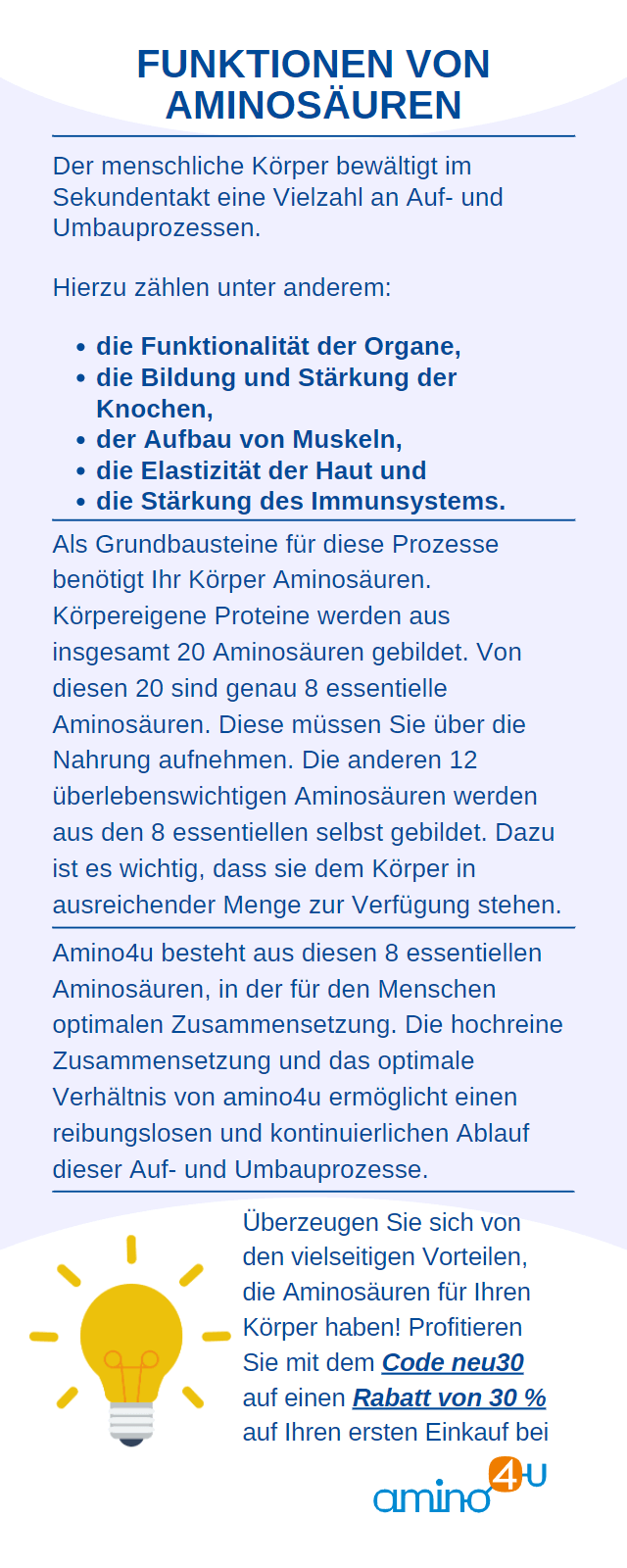Amino acids differ in their chemical structure. You may have heard of sulfur-containing aminos. Methionine and cysteine contain sulfur in their chemical composition. Here we will introduce sulfur-containing amino acids in more detail and explain their functions in our body.
Sulfur-containing amino acids & their special features
Proteinogenic amino acids are the building material of every body tissue. They are also known as
protein or protein building blocks . The building blocks form
chains of different lengths. From this we build the body's own proteins and peptides. The human organism can form some of these building blocks itself. Others have to be taken in again and again with food. Therefore, proteinogenic aminos are divided into two different main groups. There are essential and
non-essential amino acids . There is also the third group:
semi-essential amino acids .
Chemical structure
According to their chemical structure, aminos consist of
a main chain and several side chains . The structure of the side chains differs slightly for the individual
amino acids . These differences create various subcategories according to which the building blocks can be further subdivided. Among these categories there is also one in which
sulfur is contained in the side chain . In chemical nomenclature,
S appears in the chemical structure of two building blocks. This characteristic applies to the
non-essential amino acid cysteine and the essential methionine .

A special mineral
Sulfur compounds are found in almost all living organisms. Also in the human body, where the mineral makes up an average of 0.25% in all body tissues. Overall, the total sulfur content in the human organism can be around 0.6%. The mineral is considered indispensable for various cell functions. Among other things, it contributes to the stabilization of certain protein structures. It is also a component of some enzymes. The latter perform catalytic functions in our body. This means that they promote reactions between various other substances or even make them possible in the first place. They behave like a kind of spark that sets off a biochemical reaction.
Methionine
The
sulfur-containing, essential amino acid must be consumed through the diet. The need for methionine can vary from person to person. On average, values between 13 mg and 16 mg/kilogram of body mass are assumed here. Under certain conditions, this requirement can increase to up to 21 mg/kilogram of body weight.
For example, methionine is found in the following foods:
- beef
- poultry meat
- nuts
- sesame
- Salmon
- soybeans.
Among other things, methionine plays a role in the
formation of L-carnitine . L-Carnitine is a substance in the human body that is crucially involved in
energy metabolism in human cells. The substance transports fatty acids to the mitochondria, the power plants in our cells.
Cysteine is also formed from methionine. This is the second protein building block that has a
sulfur building block in the side chain.

Other functions of methionine
Methionine has additional tasks and
functional areas : The protein building block is a precursor to
taurine . This non-proteinogenic protein building block protects, among other things,
heart health . It is also involved in the formation of
glutathione . This is a substance that has
an antioxidant effect. Antioxidant substances fight so-called free radicals. These are reactive and aggressive oxygen particles that can damage cells. Vitamin C, vitamin E, the mineral selenium and various other substances are also antioxidants. Methionine also plays a role in selenium metabolism. Methionine also supports
- liver function and health by breaking down excessive fat deposits.
- the regeneration of the kidneys.
- the detoxification of heavy metals in the body such as lead.
Methionine in medical use
By consuming larger amounts of methionine, urine acidification can be achieved. This effect occurs when excess methionine forms sulfuric acid. This applies, for example, to bladder infections that are treated with antibiotics. Methionine can help to inhibit bacterial growth by acidifying the urine. As a cat owner, you may also encounter methionine in pet food. Cats often suffer from diseases of the urinary and renal tracts. Acidifying the urine is also useful here.

Cysteine
The second and
non-essential sulfur-containing amino acid is cysteine. The protein building block is produced by our organism itself with methionine and homocysteine. It is also found in various foods, such as:
- Salmon
- chicken eggs
- poultry meat
- pork meat
- sunflower seeds.
The
sulfur-containing cysteine is an essential component of various fiber proteins, which are collectively known as keratin. Cysteine is the basis of skin, hair and nails. Similar to methionine, cysteine is involved in the formation of various other important substances, including:
- Glutathione
- Taurine
- Coenzyme A
Requirement values isolated from methionine are generally not given for cysteine. Cysteine, on the other hand, is often considered together with methionine because both
amino acid proteins contain sulfur compounds and have overlapping functions.

Cysteine in medical use
Cysteine is used to make some pharmaceutical substances that you may know as
NAC or
ACC . These active ingredients are said to be able to liquefy thick mucus in various bronchial and lung diseases. Cysteine is also used to prevent radiation damage and some neurological diseases. Newborns, premature babies and people suffering from cirrhosis of the liver do not have a certain enzyme that ensures the formation of cysteine. Here, cysteine may have to be constantly supplied from outside, as is the case with an essential amino acid.
What is homocysteine?
You may have heard of homocysteine in connection with the health of your blood vessels. Now you may be wondering if
cysteine and homocysteine are related. Homocysteine is also a protein building block, but it does not belong to the group of proteinogenic building blocks. This means that homocysteine does not contribute to tissue formation. This protein building block plays a part in the body's own production of cysteine. Homocysteine takes part in the conversion processes of protein building blocks and other substances in the human body. However, elevated levels of homocysteine are associated with various diseases. According to modern
scientific findings, the so-called calcification of the blood vessels is largely linked to increased levels of
homocysteine . Similar connections are also discussed with various dementias. Among other things, a lack of vitamin B12 can contribute to the presence of too much homocysteine.
Sulfur compounds in protein building blocks are indispensable
Sulfur-containing amino acids have a special place in the group of proteinogenic building blocks. Our organism needs these aminos not only for the formation of tissue, for example skin, hair and nails. They are also important for liver health and in the fight against oxidative substances.
The importance of sulfur-containing amino acids can therefore hardly be overestimated. Since they are the precursors of various antioxidants, you may benefit from these two
aminos , especially as you age. Oxidative processes are increasingly being linked to aging. However, the need for research on this topic is still high.







